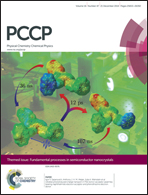Electrochemical setup – a unique chance to simultaneously control orbital energies and vibrational properties of single-molecule junctions with unprecedented efficiency†
Abstract
Impressive advances in nanoscience permit nowadays the manipulation of single molecules and broad control of many of their properties. Still, tuning the molecular charge and vibrational properties of single molecules embedded in nanojunctions in broad ranges escaped so far to an efficient control. By combining theoretical results with recent experimental data, we show that, under electrochemical control, it is possible to continuously drive a redox molecule (viologen) between almost perfect oxidized and reduced states. This yields an unprecedentedly efficient control of both vibrational frequencies and the surface-enhanced Raman scattering (SERS) intensities. The broad tuning achieved under electrochemical control by varying the overpotential (“gate potential”) within experimentally accessible ranges contrasts to the case of two-terminal setups that require high biases, which real nanojunctions cannot withstand. The present study aims to stimulate concurrent transport and SERS measurements in an electrochemical setup. This may open a new avenue of research that is not accessible via two-terminal approaches for better understanding the transport at the nanoscale.


 Please wait while we load your content...
Please wait while we load your content...